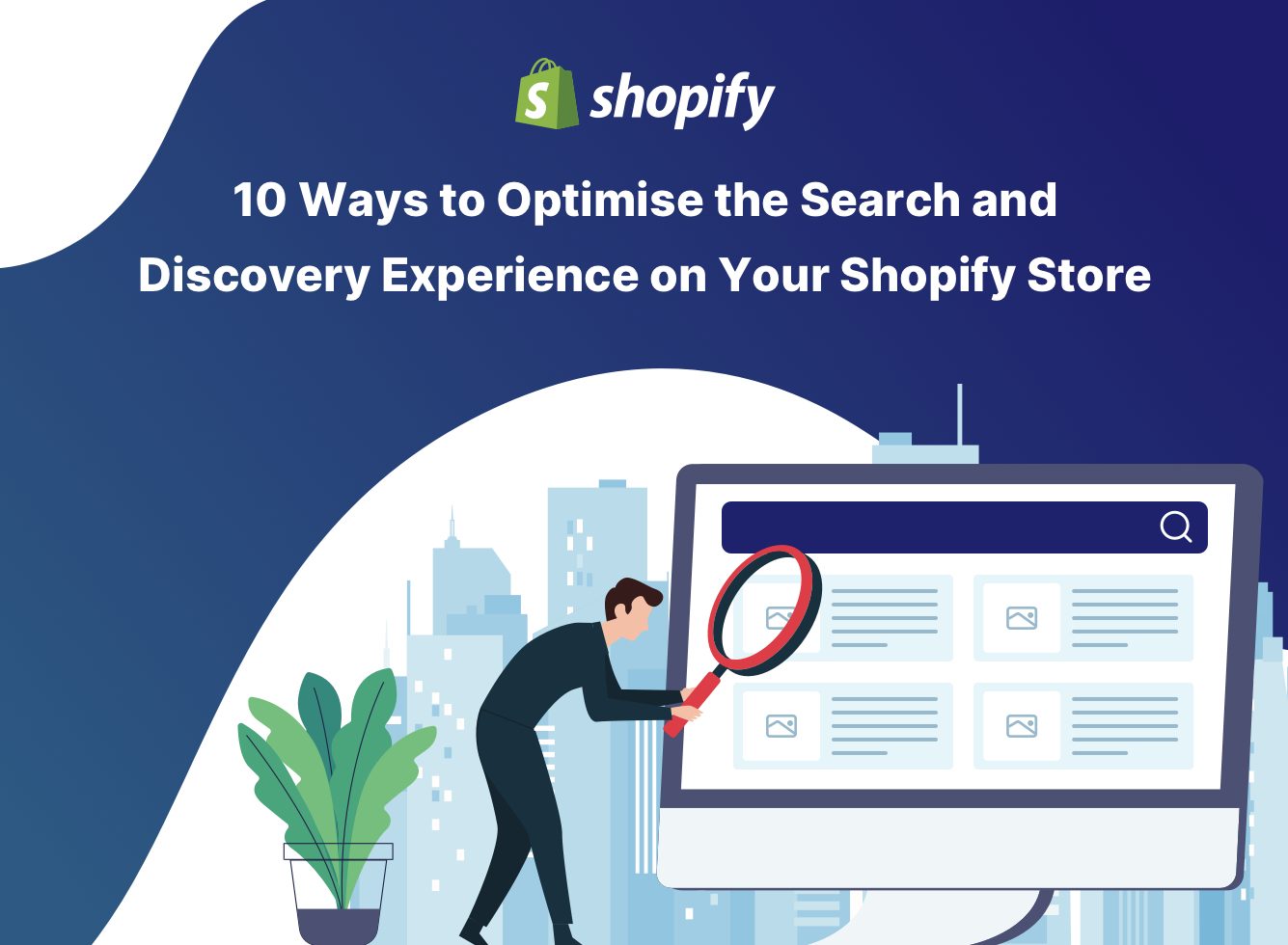10 Ways to Optimise the Search and Discovery Experience on Your Shopify Store

Your search function is one of the most powerful conversion tools on your site. Research has shown that when internal search features are working well, shoppers who use the search bar are 1.8 times more likely to convert than those who don’t. Merchants can use a variety of methods to optimise Shopify search functionality in their stores, making it easier for shoppers to find what they’re looking for — and increasing the chances that they’ll make a purchase.
If you’re an eCommerce business, read on for some useful tips on how to optimise the search functionality for your Shopify store.
Search Vs Discovery — What's the Difference?
Let’s say you visit a Shopify site, and you have a very specific item in mind — perhaps a pair of black Nike running shoes in size 8. You head to the Shopify search bar and type in ‘black running shoes size 8’. This is an example of a search. You know exactly what you’re looking for, and you’re using the search bar to find it.
Now, while you’re looking for your black running shoes, you come across a recommendation for a pair of grey trainers that you really like. You click on them to find out more. This is an example of discovery — you weren’t really aware of this product until you found it while you were looking for something else. Well-placed and appropriate recommendations can lead to discovery. Both search and discovery are important when it comes to converting site visitors into paying customers.
How Important are Search and Discovery?
The short answer is “very” important. It stands to reason that if people can’t find what they’re looking for on your site, they’re not going to buy anything. In fact, 46% of shoppers say that the ability to search and find products easily is the most important factor in their decision to purchase from a particular eCommerce site. If your store’s search options aren’t optimised, you could lose out on many potential sales.
Here are four benefits of optimising Shopify search and product recommendations in your store.
You can determine which products shoppers see first
Imagine you have a pair of shoes that are selling well, but you have another pair of shoes that you want to promote because they’re new or because they’re not selling as well as you’d like. When you optimise search for Shopify stores, you can ensure that the shoes you want to promote are the ones that shoppers see first when they search for ‘shoes’. This is an excellent way to increase sales of particular products that may otherwise have been overlooked.
You can boost customer satisfaction and increase loyalty
Customers love it when a brand makes life easy for them. There’s nothing more frustrating than trawling through hundreds of products on an eCommerce site only to find that the item you’re looking for is out of stock. If your Shopify search options are optimised in your store, shoppers can easily find what they’re looking for and they’re more likely to be satisfied with their experience. This higher satisfaction can lead to loyalty and repeat purchases down the line.
You can enhance your store’s conversion rate
Your conversion rate is the percentage of people who visit your store and make a purchase. If people can actually find what they’re looking for, or even what they weren’t looking for but would be interested in, they’re more likely to convert. In other words, search and discovery play a big part in whether people actually buy something from your store.
You can increase overall sales
Logically, if shoppers are able to complete their customer journey and find what they’re looking for — whether that’s through search or discovery — your overall sales will increase. And if you don’t follow Shopify best practices for SEO, you may miss out on many potential sales.
10 Ways You Can Optimise Search and Discovery in Your Shopify Store
Now that we’ve established how important search and discovery are, let’s take a look at some practical ways you can optimise them in your Shopify store.
-
Think About Search Terms
-
Filters are Your Friend
-
Provide Federated Search
-
Deliver Personalised Recommendations
-
Design for Mobile
-
Leverage the full Potential of Discoveries
-
Optimise your Navigation Options
-
Enable Autocomplete
-
Base Search Results on Shopper Location
-
Take Advantage of Machine Learning
It might not be possible to get in your shoppers’ heads and know exactly what they’re going to search for, but you can make an educated guess. You might stock a range of women’s boots, but will the search terms be different if your visitors are looking for ankle boots or knee highs? What about colour — will they search for black boots or brown boots? Do they want a high heel ankle boot or a low heel ankle boot?
Including as many relevant search terms as possible in your product descriptions and tags will help shoppers find what they’re looking for, and it will keep your results relevant to the people searching for your products. You also need to consider that typos are likely to happen, and account for these mistakes in your Shopify search terms. Shoppers may also use plural search terms — for example, ‘shoes’ vs ‘shoe’. Regardless, you want to make sure your products can be found no matter how someone searches for them.
Perhaps one of the most important search tools at your disposal is the filter. Filters allow shoppers to narrow down their Shopify search results so they can find exactly what they’re looking for. For example, if a shopper is looking for a pair of black ankle boots, they can use the filters to search only for black ankle boots in their size. You might not be able to predict the exact search terms each shopper will use, but filters give them the power to search however they want, and that’s invaluable.
Search facets are another way to help shoppers filter their search results. Search facets are the different attributes of a product, such as colour, size, or style. They help shoppers to further define their search intentions and narrow down their results to find the perfect product.
Federated search simply means that your search results come from more than one source. If you have multiple product catalogues, each containing hundreds or even thousands of products, you need a way to quickly search through all of them at once. This can be a challenge, but there are Shopify search products and tools that can help, like third-party search apps that provide federated search. This type of search can increase the chances of shoppers finding what they’re looking for, and it can allow your site to search vast data sets quickly and easily.
Personalised recommendations are products displayed alongside search results under headings such as “similar products” or “you might like these”. They’re based on the shopper’s search history and past behaviour on your site, and they can be a powerful way to guide shoppers to the products they are most likely to buy. You can use personalised recommendations to upsell, cross-sell, and encourage shoppers to add more items to their carts. And the best part is, they’re completely automated. Once you set them up, they’ll do the work for you.
These days, more and more people are shopping on their mobile devices. In fact, in the UK, mobile accounted for 60% of all eCommerce sales in 2021. This trend is only going to continue, so it’s important to make sure your store is designed for mobile. This means having a responsive design that looks good and is easy to use on all screen sizes, as well as making sure your search and discovery experience is optimised for mobile.
Small Shopify web development and design choices can make a big difference. For example, when users click on a product and then go back to return to their search results, they should be taken back to the same spot on the page where they left off. If they have to scroll all the way down to the bottom to find their place again, or worse, start the search again, they’re likely to get frustrated and give up. Paying attention to details like this will help you create a mobile search and discovery experience that’s smooth and seamless, no matter what device your shoppers are using.
There is a subtle difference between Shopify discovery and recommendations. Recommendations are based on past search behaviour, while discoveries are based on trends. For example, if you sell clothes, some of the products you recommend to shoppers might be based on the fact that they’ve searched for and viewed similar items in the past. But you can also use Shopify discovery to show them items that are popular with other shoppers, or that are new to your store. This can be a great way to introduce shoppers to new products they might not have otherwise considered.
Your navigation options play a big role in the Shopify search and discovery experience on your site. The user experience should be intuitive, so that shoppers can easily find their way around. This means having a well-designed navigation menu that’s easy to use and providing search and filtering options that are easy to find. Moving between search results and product pages should be quick and easy, with no more than a few clicks required. The search experience should be the same on all devices, whether shoppers are using a desktop, laptop, tablet, or smartphone.
Autocomplete is a search feature that suggests search terms as the shopper types. This serves two purposes. First, it can help shoppers find the right product faster. Second, it helps reduce problems such as typos, which can lead to search results that are either irrelevant or non-existent. Autocomplete is a great way to improve the Shopify search experience for your website users, and if you want to follow search best practices then you should have it enabled.
This may not always be appropriate, depending on the products you sell. But if you sell products that are only available in certain regions, it makes sense to base search results on the shopper’s location. That way, they’ll only see results for products that are available to them. This can save a lot of time and frustration, and it’s something that’s easy to set up in Shopify.
You may also have products that sell particularly well in certain regions. Shoppers based in one city or country might have a stronger interest in certain products than shoppers in another region. If this is the case, you can use search results to target these shoppers with relevant products. Alternatively, you may have a brick-and-mortar store in a certain location, and you want to use search results to promote products that are available in-store.
Machine learning refers to the ability of computers to learn and improve from experience. In relation to search for Shopify stores, this means that search results can get better over time. The more data you have, the more accurate your search results will be. This is because machine learning algorithms can take into account a wide range of factors, including search history, purchase history, browse abandonment, and a whole lot more. Over time, the algorithm can predict what shoppers are most likely to purchase and provide them with the most relevant results.
Hire Shopify Developers to Optimise Search and Discovery
Your Shopify store’s ability to provide a great search and discovery experience is one of the most influential factors in determining whether shoppers will buy from you or not. If your store’s search functionality is not optimised, it can lead to a poor user experience, which will result in lost sales and a higher abandonment rate. If you’re not sure how to optimise search and discovery on your site, the best thing to do is to hire Shopify developers who have experience in this area. With an in-depth knowledge of Shopify best practices, they’ll be able to help you make the necessary changes to improve search and discovery on your eCommerce site.
Here at Vsourz, we have a team of experienced Shopify developers who are readily available to help you optimise search and discovery on your store. Contact our Shopify eCommerce development company today.






